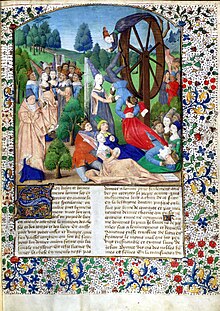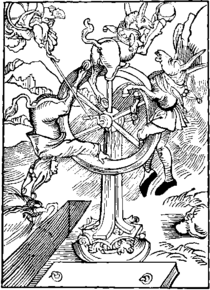|
Rota Fortunae
 In medieval and ancient philosophy, the Wheel of Fortune or Rota Fortunae is a symbol of the capricious nature of Fate. The wheel belongs to the goddess Fortuna (Greek equivalent: Tyche) who spins it at random, changing the positions of those on the wheel: some suffer great misfortune, others gain windfalls. The metaphor was already a cliché in ancient times, complained about by Tacitus, but was greatly popularized for the Middle Ages by its extended treatment in the Consolation of Philosophy by Boethius from around 520. It became a common image in manuscripts of the book, and then other media, where Fortuna, often blindfolded, turns a large wheel of the sort used in watermills, to which kings and other powerful figures are attached. Origins The origin of the word is from the "wheel of fortune"—the zodiac, referring to the Celestial spheres of which the 8th holds the stars, and the 9th is where the signs of the zodiac are placed. The concept was first invented in Babylon and later developed by the ancient Greeks, with early references from Cicero's In Pisonem. Cicero wrote: “The house of your colleague rang with song and cymbals while he himself danced naked at a feast, wherein, even while he executed his whirling gyrations, he felt no fear of the Wheel of Fortune” ("cum conlegae tui domus cantu et cymbalis personaret cumque ipse nudus in convivio saltaret, in quo cum illum saltatorium versaret orbem, ne tum qui dem fortunae rotam pertimescebat")."[1] The concept somewhat resembles the Bhavacakra, or Wheel of Becoming, depicted throughout Ancient Indian art and literature, except that the earliest conceptions in the Roman and Greek world involve not a two-dimensional wheel but a three-dimensional sphere, a metaphor for the world. It was widely used in the Ptolemaic perception of the universe as the zodiac being a wheel with its "signs" constantly turning throughout the year and having effect on the world's fate (or fortune). In the second century BC, the Roman tragedian Pacuvius wrote:
The idea of the rolling ball of fortune became a literary topos and was used frequently in declamation. In fact, the Rota Fortunae became a prime example of a trite topos or meme for Tacitus, who mentions its rhetorical overuse in the Dialogus de oratoribus.  In the second century AD, astronomer and astrologer Vettius Valens wrote:

BoethiusThe goddess and her Wheel were eventually absorbed into Western medieval thought. The Roman philosopher Boethius (c. 480–524) played a key role,[5] utilizing both her and her Wheel in his Consolatio Philosophiae. For example, from the first chapter of the second book:
Boethius had a unique perspective on Fortune and blended the concepts from Paganism and Christianity. The Pagans viewed Fortune as an "independent ruling power", whereas Christians viewed Fortune as a "power completely subservient to another God".[7] This allowed Boethius to depict Fortune as having power without denying the fact that a Christian God has control. In the middle ages Religious instructionThe Wheel was widely used as an allegory in medieval literature and art to aid religious instruction. Though classically Fortune's Wheel could be favourable and disadvantageous, medieval writers preferred to concentrate on the tragic aspect, dwelling on downfall of the mighty – serving to remind people of the temporality of earthly things. In the morality play Everyman (c. 1495), for instance, Death comes unexpectedly to claim the protagonist. Fortune's Wheel has spun Everyman low, and Good Deeds, which he previously neglected, are needed to secure his passage to heaven. Geoffrey Chaucer used the concept of the tragic Wheel of Fortune a great deal. It forms the basis for the Monk's Tale, which recounts stories of the great brought low throughout history, including Lucifer, Adam, Samson, Hercules, Nebuchadnezzar, Belshazzar, Nero, Alexander the Great, Julius Caesar and, in the following passage, Peter I of Cyprus.
~ Geoffrey Chaucer, The Canterbury Tales, The Monk's Tale[8] Fortune's Wheel often turns up in medieval art, from manuscripts to the great Rose windows in many medieval cathedrals, which are based on the Wheel. Characteristically, it has four shelves, or stages of life, with four human figures, usually labeled on the left regnabo (I shall reign), on the top regno (I reign) and is usually crowned, descending on the right regnavi (I have reigned) and the lowly figure on the bottom is marked sum sine regno (I am without a kingdom). Dante employed the Wheel in the Inferno and a "Wheel of Fortune" trump-card appeared in the Tarot deck (circa 1440, Italy). Political instruction In the medieval and renaissance period, a popular genre of writing was "Mirrors for Princes", which set out advice for the ruling classes on how to wield power (the most famous being The Prince by Niccolò Machiavelli). Such political treatises could use the concept of the Wheel of Fortune as an instructive guide to their readers. John Lydgate's Fall of Princes, written for his patron Humphrey, Duke of Gloucester is a noteworthy example. Many Arthurian romances of the era also use the concept of the Wheel in this manner, often placing the Nine Worthies on it at various points.
Like the Mirrors for Princes, this could be used to convey advice to readers. For instance, in most romances, Arthur's greatest military achievement – the conquest of the Roman Empire – is placed late on in the overall story. However, in Malory's work the Roman conquest and high point of King Arthur's reign is established very early on. Thus, everything that follows is something of a decline. Arthur, Lancelot and the other Knights of the Round Table are meant to be the paragons of chivalry, yet in Malory's telling of the story they are doomed to failure. In medieval thinking, only God was perfect, and even a great figure like King Arthur had to be brought low. For the noble reader of the tale in the Middle Ages, this moral could serve as a warning, but also as something to aspire to. Malory could be using the concept of Fortune's Wheel to imply that if even the greatest of chivalric knights made mistakes, then a normal fifteenth-century noble didn't have to be a paragon of virtue in order to be a good knight. Carmina BuranaThe Wheel of Fortune motif appears significantly in the Carmina Burana (or Burana Codex), albeit with a postclassical phonetic spelling of the genitive form Fortunae. Excerpts from two of the collection's better known poems, "Fortuna Imperatrix Mundi (Fortune, Empress of the World)" and "Fortune Plango Vulnera (I Bemoan the Wounds of Fortune)," read:
Later usageFortune and her Wheel have remained an enduring image throughout history. Fortune's wheel can also be found in Thomas More's Utopia. Shakespeare William Shakespeare in Hamlet wrote of the "slings and arrows of outrageous fortune" and, of fortune personified, to "break all the spokes and fellies from her wheel." And in Henry V, Act 3 Scene VI[10] are the lines:
Shakespeare also references this Wheel in King Lear. The Earl of Kent, who was once held dear by the King, has been banished, only to return in disguise. This disguised character is placed in the stocks for an overnight and laments this turn of events at the end of Act II, Scene 2:[11]
In Act IV, scene vii, King Lear also contrasts his misery on the "wheel of fire" to Cordelia's "soul in bliss". Rosalind and Celia also discuss Fortune, especially as it stands opposed to Nature, in As You Like It, Act I, scene ii. Throughout Shakespeare's works, Fortuna is a powerful force that can make even kings go from greatness to ruin with her wheel. She is often used as a scapegoat to blame when someone experiences a disaster.[12] Victorian eraIn Anthony Trollope's novel The Way We Live Now, the character Lady Carbury writes a novel entitled The Wheel of Fortune about a heroine who suffers great financial hardships. ReferencesWikimedia Commons has media related to Wheel of Fortune.
|
![Statuette[2] of the Roman god Fortuna, with gubernaculum (ship's rudder),[3] Rota Fortunae (wheel of fortune) and cornucopia (horn of plenty) found near the altar at Castlecary in 1771.[4]](http://upload.wikimedia.org/wikipedia/commons/thumb/7/78/Titulihunteriani00macdrich_raw_0143.png/144px-Titulihunteriani00macdrich_raw_0143.png)